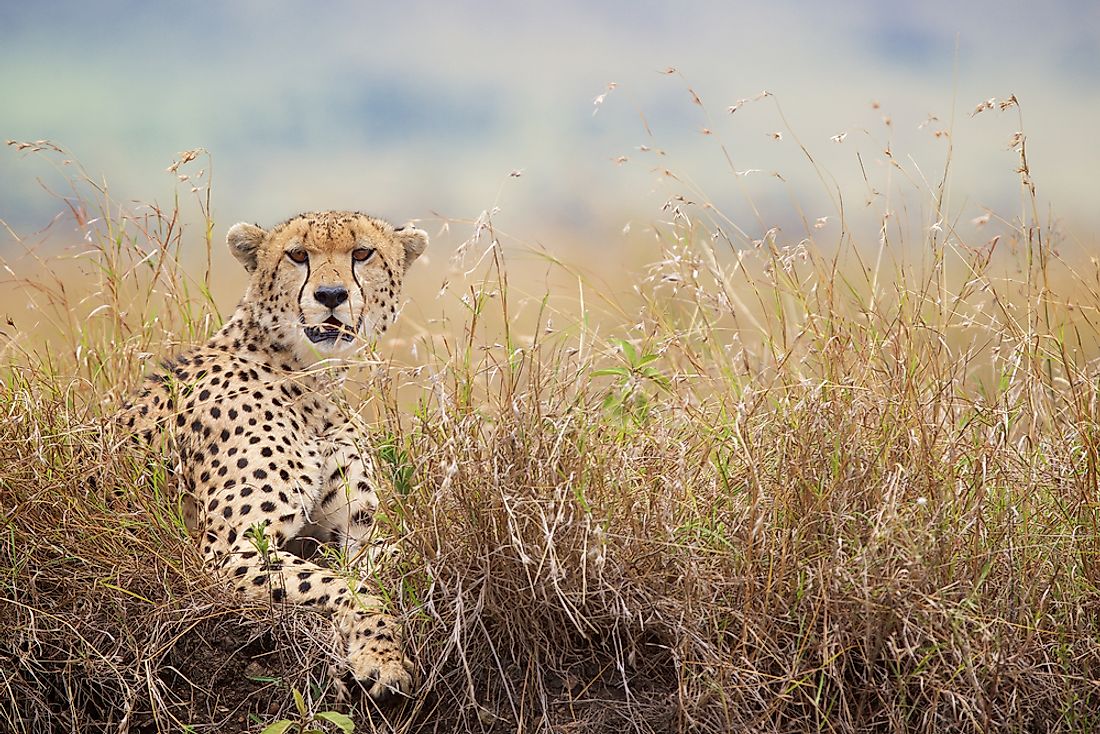How Many Types Of Cheetahs Are There?

The cheetah is a big cat of the Felinae subfamily. They are found primarily in southern and eastern Africa, as well as in Iran. The animals belong to the genus Acinonyx and are characterized by a slender body, spotted coat, black tear-like stripes, deep chest, long thin legs, and a spotted tail. Here is a description of the five extant subspecies of cheetahs.
5. Tanzanian cheetah
The Tanzanian cheetah, also known as the Kenyan cheetah or the East African cheetah (Acinonyx jubatus raineyi) is native to East Africa. This cheetah subspecies inhabits the savannahs and grasslands of Tanzania, Uganda, Somalia, and Kenya. The IUCN lists the subspecies as vulnerable as predation, cheetah cub mortality, and habitat loss threatens the survival of these animals. The Tanzanian cheetahs are the second largest population of cheetah after the South African subspecies. However, these animals have gone regionally extinct in the three countries of DRC, Rwanda, and Burundi. It is the largest cheetah subspecies, measuring between 110 to 135 cm from head to body. It is the second palest subspecies after the Northwest African cheetah. The coat color varies from white-yellowish to tannish. Cheetahs of color variations like melanism and ticked are also found. The cat possesses numerous round black spots in most parts of the body except on the white underside. These spots merge towards the tail end to form 4 to 14 dark rings with a white tuft at the tail tip.
4. Sudan cheetah
The Sudan cheetah, also known as the Somali cheetah, Central African cheetah or Northeast African cheetah, (Acinonyx jubatus soemmeringii) lives in the savannahs, grasslands, deserts, and arid areas of Central and Northeast Africa. The population is fragmented in many parts of their range and nearly extinct in Sudan. These cheetahs are threatened with habitat loss, and smuggling to the Middle East and are thus classified as Vulnerable by the IUCN. The Sudan cheetah closely resembles the Tanzanian cheetah in appearance. The black dorsal spots of the cheetah are most widespread and separated but are smaller than that of the Tanzanian subspecies. However, no spots are present on the hind legs.
3. South African cheetah
The South African cheetah or the Namibian cheetah (Acinonyx jubatus jubatus) is the most numerous subspecies of cheetah. The cheetah can be found in the savannahs of the Okavango Delta, grasslands of the Transvaal, farmlands of Namibia, and the arid areas of the Kalahari. Although it has the highest population among other subspecies, the South African cheetah faces considerable threat from human activities. It has gone extinct in Malawi, Lesotho, and the DRC. The wild cat is medium-sized with the adult male being about 168 to 200 cm long. The South African cheetah have a golden or bright yellow coat, and a white underside. The spots of the animal are more dense than that of the other subspecies and are more pronounced on the face.
2. Northwest African cheetah
The Northwest African cheetah, also known as the Saharan cheetah or the Senegal cheetah (Acinonyx jubatus hecki), is native to Northwest Africa. It is one of the most threatened subspecies of cheetah and is classified as critically endangered by the IUCN. Only about 250 mature individuals survive in the wild. The appearance of the cheetah is quite distinct from other subspecies. The coat of the animal is nearly white in color and shorter with spots gradually fading from black on the back to brown on the legs. The face nearly lacks spots and even the tear stripes are often missing.
1. Asiatic cheetah
The Asiatic cheetah or the Iranian cheetah (Acinonyx jubatus venaticus) is the rarest of all cheetah subspecies and is only found in Iran. The range of this animal was once widespread across the Arabian Peninsula and the Near East, and even all the way across to India. However, the species is today classified as Critically Endangered by the IUCN. It now survives only in the protected areas of Iran. This cheetah subspecies separated from its African counterpart sometime between 32,000 and 67,000 years ago. The Asiatic cheetah has a buff to light fawn-coloured fur. The head and neck exhibit small black spots that are arranged in lines.











